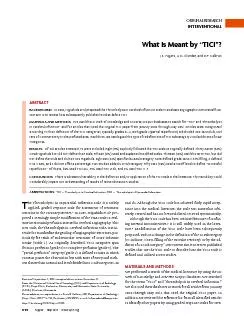

ThrombolysisinCerebralInfarctionTIMIThrombolysisinMyocardialInfarction heThrombolysisinMyocardialInfarctionscaleisawidelyappliedgradedresponsescaleforassessmentoftreatmentoutcomeinthecoronaryarterie ID: 840153
Download Pdf The PPT/PDF document "ORIGINALRESEARCHWhatIsMeantbyTICIJEFugat..." is the property of its rightful owner. Permission is granted to download and print the materials on this web site for personal, non-commercial use only, and to display it on your personal computer provided you do not modify the materials and that you retain all copyright notices contained in the materials. By downloading content from our website, you accept the terms of this agreement.
1 ORIGINALRESEARCHWhatIsMeantbyTICI?J.E.
ORIGINALRESEARCHWhatIsMeantbyTICI?J.E.Fugate,A.M.Klunder,andD.F.KallmesIn2003,HigashidaetalproposedtheThrombolysisInCerebralInfarctionscaletoevaluateangiographicintracranialow.OuraimistoreviewhowsubsequentlypublishedstudiesdeneTICI.MATERIALSANDMETHODS:WeusedtheISIWebofKnowledgeandSciVerseScopusdatabasestosearchforTICIandthrombolysis ThrombolysisinCerebralInfarction;TIMIThrombolysisinMyocardialInfarction heThrombolysisinMyocardialInfarctionscaleisawidelyapplied,gradedresponsescaleforassessmentoftreatmentoutcomeinthecoronaryarteries.In2003,HigashidaetalposedaseeminglysimplemodificationoftheTIMIscaletoeval-uateintracranialperfusionassessedincerebralangiography.This ReceivedSeptember3,2012;acceptedafterrevisionDecember13. bralperfusion,whetherornotthesepapersreferencedorutilizedtheoriginalTICIpaper.IntheinitialdescriptionoftheTICIscalein2003,grade0indicatesnoperfusionasevidencedbynoantegradeflowbeyondthepointofarterialocclusion.Grade1isdefinedaspenetrationwithminimalperfusionandapplieswhenthecontrastmaterialpassesbeyondtheareaofobstructionbutfailstoopacifytheentirecerebralbeddistaltotheobstruction.Grade2isbroadlydefinedaspartialperfusion,whichoccurswhenthecontrastmaterialpassesbeyondtheobstruction,opacifiesthedistalarterialbed,buttherateofentryofcontrastand/oritsrateofclearancefromthevascularbedareslowerthancomparableareasnotperfusedbythepreviouslyoccludedvessel.Theoppositecerebralarteryorthearterialbedproximaltotheocclusioncanbeusedforcom-parisonrates.Grade2issubdividedinto2aand2b.Agradeof2aindicatespartialfilling(lessthantwo-thirds)oftheentirevascularterritoryand2bindicatescompletefillingoftheexpectedvascularterritory,butwithaperceptiblyslowerfillingratethannormal.Finally,grade3isdefinedascompleteperfusionandapplieswhenantegradeflowintothebeddistaltotheobstructionoccursaspromptlyasintotheobstructionandclearanceofthecontrastmaterialfromtheinvolvedbedisasrapidasfromanuninvolvedotherbedofthesamevesselortheoppositecerebralartery.Withourliteraturesearch,weidentifiedatotalof236articles.WeexcludedarticlesthatdidnotrelatetotheTICIscale(115articles)andarticlesthatwereinlanguagesotherthanEnglishorthatwerenotaccessibleinfulllength(49articles).Wequalita-tivelyassessedwhetherthedefinitionofTICIineacharticlead-heredtotheoriginaldefinitionoftheTICIscaleandevaluatedthearticlesthatwerecitedwhenTICIwasdescribed.Wethenaccord-inglycategorizedthearticlesinto4groups:1)articlesthatexplic-itlystatedthescaleandfollowedtheoriginalTICIscalecom-pletely,2)articlesthatdidnotexplicitlydefinethescalebutcitedtheoriginalTICIpaper,3)articlesthatdefinedamodifiedscale,and4)articlesthatusedTICIbutdidnotdefinethescaleanddidnotcitetheoriginalTICIpaper.Wealsocataloguedthetypeandnumberofdefinitionsofsubcategory2aandnotedifasubcate-goryofTICIwasusedasathresholdforsuccessfulrevasculariza-tion.ThisstudywasexemptfrominstitutionalreviewboardOf74totalincludedarticles,8(11%)followedtheoriginalTICIscalecompletelyandexplicitlystatedthecategories.Onearticleclaimedtohavefollowedthescalecompletelybutdidnotstatethecategories.Thirty-seven(50%)articlesdidnotexplicitlydefinethescalebutstillcitedtheoriginalpaperbyHigashidaetModificationsoftheTICIscalewereusedin15(20%)Ofthese,8citedonlytheoriginalTICIpaper,4citedtheoriginalTICIpaperandotherpapers,and3citedonlyotherpapers.Thirteen(18%)articlesusedTICIbutdidnotdefinethescaleanddidnotcitetheoriginalTICIpaper.TheseresultsaredepictedinFig1.Eighteen(24%)ofarticlesmentionedtherateofcontrastfill-ingintheiruseofTICI.MostmodificationsofTICIeliminatedthesubcategoriesof2aand2b.Only18(24%)articlesspecifieda2asubcategory.Ofthese,9defined2aasfillingof67%oftheaffectedvascularterritory(compatiblewiththeoriginalTICI)and6defined2aasfillingof50%oftheaffectedvascularterri-tory.A2csubcategorywasaddedin2articles,andacategory4wasaddedin1article.ExamplesofthevariabilityindefinitionsofTICIcategoriesaredetailedinTable2.Mostarticles(52,70%)definedathresholdwithintheTICIscalethatindicatedsuccessfulrevascularizationasoneofthestudyendpoints.Ofthese,34(65%)usedTICI2,17(33
2 %)usedTICI2b(althoughonly1ofthesestudies
%)usedTICI2b(althoughonly1ofthesestudiesdefinedaprecise FIG1.DistributionofdenitionandcitationoftheTICIscaleintheliterature.ArticlesintheEnglishliteraturethatusetheTICI(Throm-bolysisinCerebralInfarction)gradingscale,distributedaccordingtodenitionandcitationofTICI.Table1:TheoriginalThrombolysisinCerebralInfarctionperfusionscale CategoryTitleDescriptionGrade0NoPerfusionNoantegradeowbeyondthepointofocclusion.Grade1PenetrationwithMinimalThecontrastmaterialpassesbeyondtheareaofobstructionbutfailstoopacifytheentirecerebralbeddistaltotheobstruction.Grade2PartialPerfusionThecontrastmaterialpassesbeyondtheobstructionandopaciesthearterialbeddistaltotheobstruction.However,therateofentryofcontrastintothevesseldistaltotheobstructionand/oritsrateofclearancefromthedistalbedareperceptiblyslowerthanitsentryintoand/orclearancefromcomparableareasnotperfusedbythepreviouslyoccludedvessel.Grade2aOnlypartiallling(lessthantwo-thirds)oftheentirevascularterritoryisvisualized.Grade2bCompletellingofalloftheexpectedvascularterritoryisvisualizedbutthellingisslowerthannormal.Grade3CompletePerfusionAntegradeowintothebeddistaltotheobstructionoccursaspromptlyasintotheobstructionandclearanceofcontrastmaterialfromtheinvolvedbedisasrapidasfromanuninvolvedotherbedofthesamevesselortheoppositecerebralartery.AJNRAmJNeuroradiol34:1792 97Sep2013www.ajnr.org cutofffor2b;67%fillingofthevascularterritory),and1used3.Thesethresholdsforsuccessfulangiographicrevascu-larizationwereprespecifiedinthemethodsin40(77%)oftheseThetermTICIconnotesastandardandwidelyacceptedmetricofrevascularization,analogoustotheubiquitousTIMIoutcomeforcoronaryrevascularization.Inthecurrentstudy,wefoundsubstan-tialvariabilityinhowthetermTICIscaleisbothdefinedandusedintherecentEnglishliterature.Farfrombeingaconsistentanduni-versalscale,wenotedthatonlyasmallminorityofstudies,byuseofthetermTICIwhenreportingoutcomesafterrevascularization,actuallyusedtheoriginalTICIscale.Furthermore,manystudiesfailedtoprovidesufficientdetailtoallowthereadertounderstandexactlywhatcategorieswereused.Finally,thedefinitionofsuccessfulrevascularizationvariedwidelyamongstudies.Thesecurrentfind-ingsarerelevantforseveralreasons.First,ourunderstandingofthecurrentliteraturehasthepo-tentialtobegreatlyaffectedbythesefindings.ThemodificationthatchangedthecutoffpointbetweenTICIsubcategories2aand2bhasparticularrelevancebecauseagradeontheTICIscalewasusedasanendpointtodefinesuccessfulreperfusioninone-thirdofthearticlesthatspecifiedthisendpointinourstudy.Second,thedefinitionofTICIwillaffectstudydesignforfuturetrialsofendovasculartherapyforacuteischemicstroke.TheTICIgradingscaleisincreasinglyusedtodefineendpointsofrevascularizationsuccessinstudies.IfwedefinesuccessasachievingacertaingradeofTICI(eg,TICI2b)butwedonothaveconsistentgradingsystems,wecannotcompareorcombineresultsofclin-icalstudies.Toachieveenoughpatientsforstudiestobepoweredadequately,itisnec-essaryforinvestigatorsfromdifferentcen-terstocollaboratetogether.Withoutastan-dardizedgradingscale,thiswillnotbepossible.Itisessentialthatwecommuni-cateclearlywithconsistentterminology.Toourknowledge,ourstudyisthefirsttospecificallydescribethevaryingdefini-tionsoftheTICIscaleasitisreportedintheliterature.Others,however,haveprevi-ouslycalledattentiontotheconfusionsur-roundingtheTICIscale.In2007,Tomacknowledgedconfusionaboutthedifferentrevascularizationscales.Henotedtheinconsistentdescriptionsandapplica-tionsintheliterature;somefocusonrecan-alization,somefocusonreperfusion,andothersconfusingly(anderroneously)usethetermsinterchangeably.LettersdenotingacronymsfordifferentscalesarelitteredthroughouttheliteratureandincludetheTICI,TIMI,TIBI(ThrombolysisinBrainIschemia),andAOL(ArterialOcclusiveLe-sion)scales.InapreviousreviewoftheTICIscale,theinherentinconsistencieswithintheoriginalTICIscaleitselfwereidentified.Forexample,thereisnoapplicableTICIgradeforacaseinwhichgreaterthantwo-thirdsbutlessthancompletefillingofthevascularterritoryisvisualized.Inaddition,thereisnoapplicableTICIgradeforapartiallyrevascu-
3 larizedterritorywithnormalrateofdistalop
larizedterritorywithnormalrateofdistalopacification,asce-narionotuncommonlyencountered.TheTIMIscaleunliketheTICIscalehasnotbeenthesub-jectoffrequentmodifications.ThedefinitionoftheTIMIscalethroughouttheabundantcardiologyliteraturehasnotbeensys-temicallyevaluated,butthereisgeneralconsensusthatwhenusedfortheevaluationofmyocardialperfusionbeforeandaftercoro-naryreperfusiontherapies,itisusedconsistently.Inthemid1990s,aquantitativeassessmentofcoronaryflowcalledthecorrectedTIMIFrameCount(CTFC)wasreportedinanattempttostandardizethescale,buttheoriginalsemiqualitativeTIMIscalehascontinuedtobethestandardusedbyinterventionalcardiologists.However,theTIMIscalecannotbeeasilyappliedtothemorecomplexcerebralarteries.Onereviewfoundthat7dif-ferentoperationalizedversionsoftheTIMIscalehavebeenusedinmajorstroketrials,emphasizingagaintheneedforasingle,uniform,consistentscaleforgradingofperfusionincerebralThisstudyhasseverallimitations.Somearticlesfromourlit-eraturesearchwerenotreviewedbecauseofalackofaccessibilityoffull-lengtharticlesorbecausetheywerewritteninlanguagesTable2:VaryingdenitionsofTICIgradesintheliterature CategoryDenitionGrade0NoowNocanalizationCompleteocclusionNorecanalization/reperfusionGrade1Minimalrecanalization(Minimalow(veryslow)withoutsignicantowdistaltotheocclusionsiteLimitedornoreperfusionDistalmovementofthrombuswithoutreperfusionPerfusionpastinitialocclusion,butlimiteddistalbranchGrade2PartialrecanalizationrecanalizationofsomebutnotalloftheoccludedIncompleterecanalization/reperfusionNear-normalow,withowdistaltotheocclusionbutnotllingthedistalbranchesnormallyGrade2aPerfusionof50%oftheMCAdistributionPartialllingoftheentirevascularterritoryPartialperfusionwithincompletedistalllingof50%ofexpectedterritoryPartialllingoftheentirevascularterritoryGrade2bPartialperfusionwithincompletedistalbranchllingof50 99%oftheexpectedterritoryCompletelling,butthellingisslowerthannormalPerfusionofhalforgreaterofthevasculardistributionoftheoccludedarteryGrade2cNear-completeperfusionwithoutclearlyvisiblethrombusbutwithdelayincontrastrun-offGrade3Fullperfusionwithllingofalldistalbranches,includingM3,M4NormalowPartialrecanalizationwith50%reperfusionFullperfusionwithnormalllingofdistalbranchesinanormalhemodynamicGrade4Completerecanalization/reperfusionFugateSep2013www.ajnr.org otherthanEnglish,creatingaselectionbias.However,increasingthenumberofstudieswereviewedmayhaveincreasedtheob-servedvariabilityinTICIdefinitions.Also,thecategoriesintowhicharticlesweredividedweresubjectivelychosenandwereevaluatedbyonly2investigators.Furtheropportunitiestorefineourgradingscalesandfurtherourunderstandingofbrainreperfusionabound.Weaknessesincurrentgradingscalesforcerebralperfusionarenotlimitedtoconfusingterminology.Vesselrecanalizationinthetreatmentofacuteischemicstrokehasbeenshowntobeassociatedwithfavor-ableclinicalfunctionaloutcomes,butwhenreperfusionisonlypartial,theclinicalrelevanceoftheuseofdifferentTICIgrade2subdivisionsisnotknown.Furthermore,therearefewdatare-gardingtheintra-observerandinterobservervariabilitywhenap-plyingtheTICIscaletoangiographyresults.Italsoremainsun-clearwhetheritisappropriatetoapplyTICItotheposteriorcirculationandwhetherthedegreeofcollateralflowparticu-larlyincaseswithdistalM34occlusionsmodifiestheeffectofrevascularization(asmeasuredbyTICI)onclinicaloutcomes.Scalesaredesignedtoaidintheobjectivedescriptionofangio-graphicresults,standardizedataforresearchstudies,andassistinoutcomeprediction.WehopethatbyclarifyingwhatwemeanbyTICI,wewillbebetterabletoevaluatetheefficacyofrevas-cularizationtherapiesforacuteischemicstrokeinthefuture.ThereissubstantialvariabilityinhowtheTICIscaleisdefinedandappliedinthecerebrovascularliterature.Fewstudiesprovidesuf-ficientdetailforreaderstounderstandwhatismeantbyeachTICIgrade.BecauseTICIscoreisincreasinglyusedasanoutcomemea-sureinstudiesofrevascularizationtherapiesinacuteischemicstroke,thisvariabilityhasthepotentialtoconsiderablyimpactresultsandourunderstandingofthesetherapies.Disclosures:DavidKallmesUNREL
4 ATED:Consultancy:Grants/GrantsPend-Micro
ATED:Consultancy:Grants/GrantsPend-MicroVention,*SequentMedical,*ev3,*BenvenueMedical;*dations/MeetingExpensesUnrelatedtoActivitiesListed:Codman*(*moneypaidto1.TIMIStudyGroup.TheThrombolysisinMyocardialInfarction(TIMI)trial:phaseIfindings.NEnglJMed2.HigashidaRT,FurlanAJ,RobertsH,etal.Trialdesignandreportingstandardsforintra-arterialcerebralthrombolysisforacuteisch-emicstroke.2003;34:e1091373.KallmesDF.TICI:ifyouarenotconfused,thenyouarenotpayingAJNRAmJNeuroradiolTheInterventionalManagementofStroke(IMS)IIStudy.5.NoserEA,ShaltoniHM,HallCE,etal.Aggressivemechanicalclotdisruption:asafeadjuncttothrombolytictherapyinacutestroke?6.KimEY,HeoJH,LeeSK,etal.Predictionofthrombolyticefficacyinacuteischemicstrokeusingthin-sectionnoncontrastCT.2006;67:1846487.KulcsarZ,BonvinC,PereiraVM,etal.Penumbrasystem:anovelmechanicalthrombectomydeviceforlarge-vesselocclusionsinacutestroke.AJNRAmJNeuroradiol2010;31:628338.LeeKY,HanSW,KimSH,etal.Earlyrecanalizationafterintrave-nousadministrationofrecombinanttissueplasminogenactivatorasassessedbypre-andpost-thrombolyticangiographyinacuteischemicstrokepatients.9.SchumacherHC,MeyersPM,HigashidaRT,etal.Reportingstan-dardsforangioplastyandstent-assistedangioplastyforintracra-nialatherosclerosis.JVascIntervRadiol10.SuhDC,KimJK,ChoiCG,etal.Prognosticfactorsforneurologicoutcomeafterendovascularrevascularizationofacutesymptom-aticocclusionoftheinternalcarotidartery.AJNRAmJNeuroradiol11.LauAY,WongEH,WongA,etal.Significanceofgoodcollateralcompensationinsymptomaticintracranialatherosclerosis.brovascDis12.LiebeskindDS,CotsonisGA,SaverJL,etal.Collateralcirculationinsymptomaticintracranialatherosclerosis.JCerebBloodFlowMetab13.RothC,PapanagiotouP,BehnkeS,etal.Stent-assistedmechanicalrecanalizationfortreatmentofacuteintracerebralarteryocclu-2010;41:25596714.LiebeskindDS,CotsonisGA,SaverJL,etal.Collateralsdramaticallyalterstrokeriskinintracranialatherosclerosis.AnnNeurol15.AlmekhlafiMA,HuWY,HillMD,etal.Calcificationandendothe-lializationofthrombiinacutestroke.AnnNeurol2008;64:3444816.ImaiK,MoriT,IzumotoH,etal.MRimaging-basedlocalizedintra-arterialthrombolysisassistedbymechanicalclotdisruptionforacuteischemicstrokeduetomiddlecerebralarteryocclusion.AJNRAmJNeuroradiol2011;32:7485217.KoleM,AminB,MarinH,etal.Intracranialangioplastyandstentplacementfordirectcerebralrevascularizationofnonacuteintra-cranialocclusionsandnearocclusions.NeurosurgFocus18.MordasiniP,FrabettiN,GrallaJ,etal.Invivoevaluationofthefirstdedicatedcombinedflow-restorationandmechanicalthrombec-tomydeviceinaswinemodelofacutevesselocclusion.AJNRAmJ2011;32:29430019.NogueiraRG,SchwammLH,BuonannoFS,etal.Low-pressurebal-loonangioplastywithadjuvantpharmacologicaltherapyinpa-tientswithacuteischemicstrokecausedbyintracranialarterialoc-2008;50:3314020.RaychevR,OvbiageleB.EndovasculartherapyofacuteischemicExpOpinPharmacother21.SuggRM,NoserEA,ShaltoniHM,etal.Intra-arterialreteplasecom-paredtourokinaseforthrombolyticrecanalizationinacuteisch-emicstroke.AJNRAmJNeuroradiol2006;27:7697322.CastanoC,DoradoL,GuerreroC,etal.MechanicalthrombectomywiththeSolitaireABdeviceinlargearteryocclusionsoftheante-riorcirculation:apilotstudy.2010;41:18364023.DeguchiI,DemboT,FukuokaT,etal.UsefulnessofMRA-DWImismatchinneuroendovasculartherapyforacutecerebralinfarc-EurJNeurol2012;19:1142024.DeshmukhVR,FiorellaDJ,AlbuquerqueFC,etal.thrombolysisforacuteischemicstroke:preliminaryexperiencewithplateletglycoproteinIIb/IIIainhibitorsasadjunctivetherapy.2005;56:465425.FeslG,PatzigM,HoltmannspoetterM,etal.Endovascularmechan-icalrecanalisationafterintravenousthrombolysisinacuteanteriorcirculationstroke:theimpactofanewtemporarystent.InterventRadiol2012;35:13263126.FroehlerMT,TateshimaS,DuckwilerG,etal.ThehyperdensevesselsignonCTpredictssuccessfulrecanalizationwiththeMercideviceinacuteischemicstroke.JNeurointerventSurg2013;5:2899327.HauckEF,OgilvyCS,SiddiquiAH,etal.Directendovascularrecan-alizationofchroniccarotidocclusion:shouldwedoit?Casereport.28.SandhuGS,ParikhPT,HsuDP,etal.Outcomesofintra-arterialthrombol
5 ytictreatmentinacuteischemicstrokepatien
ytictreatmentinacuteischemicstrokepatientswithamatcheddefectondiffusionandperfusionMRimages.JNeuroint-erventSurg2012;4:1050929.JankowitzB,AghaebrahimA,ZirraA,etal.ManualaspirationAJNRAmJNeuroradiol34:1792 97Sep2013www.ajnr.org thrombectomy:adjunctiveendovascularrecanalizationtechniqueinacutestrokeinterventions.2012;43:14081130.KangDH,HwangYH,KimYS,etal.DirectthrombusretrievalusingthereperfusioncatheterofthePenumbrasystem:forced-suctionthrombectomyinacuteischemicstroke.AJNRAmJNeuroradiol2011;32:2838731.KimSJ,HaYS,RyooS,etal.Sulcaleffacementonfluidattenuationinversionrecoverymagneticresonanceimaginginhyperacutestroke:associationwithcollateralflowandclinicaloutcomes.2012;43:3869232.KwonTH,KimBM,NamHS,etal.Carotidstentinginacuteisch-emicstrokepatientswithintraluminalthrombus.33.LiebeskindDS,SanossianN,YongWH,etal.CTandMRIearlyvesselsignsreflectclotcompositioninacutestroke.2011;42:12374334.LohY,LiebeskindDS,ShiZS,etal.Partialrecanalizationofconcom-itantinternalcarotid-middlecerebralarterialocclusionspromotesdistalrecanalizationofresidualthrombuswithin24h.JNeuroint-erventSurg2011;3:384235.MachiP,CostalatV,LobotesisK,etal.SolitaireFRthrombectomysystem:immediateresultsin56consecutiveacuteischemicstrokeJNeurointSurg2012;4:626636.MachiP,LobotesisK,MaldonadoIL,etal.EndovasculartreatmentoftandemocclusionsoftheanteriorcerebralcirculationwithSol-itaireFRthrombectomysystem:initialexperience.EurJRadiol2012;81:34798437.MordasiniP,HillerM,BrekenfeldC,etal.InvivoevaluationofthePhenoxCRCmechanicalthrombectomydeviceinaswinemodelofacutevesselocclusion.AJNRAmJNeuroradiol38.ParkMS,KimJT,YoonW,etal.Intra-arterialthrombolysisafterfull-doseintravenoustPAviatheDripandShipapproachinpa-tientswithacuteischemicstroke:preliminaryreportMedJ2011;47:9910339.ParrillaG,Garcia-VillalbaB,EspinosadeRuedaM,etal.rhage/contraststainingareasaftermechanicalintra-arterialthrombectomyinacuteischemicstroke:imagingfindingsandclin-icalsignificance.AJNRAmJNeuroradiol40.ProthmannS,LockauH,DornF,etal.ThePhenoxclotretrieveraspartofamultimodalmechanicalthrombectomyapproachinacuteischemicstroke:singlecenterexperiencein56patients.SciWorldJ[Epubaheadofprint24April2012]41.PsychogiosMN,KreuschA,WasserK,etal.RecanalizationoflargeintracranialvesselsusingthePenumbrasystem:asinglecenterex-AJNRAmJNeuroradiol2012;33:14889342.RothC,JunkD,PapanagiotouP,etal.Acomparisonof2strokedevices:thenewAperioclot-removaldeviceandtheSolitaireAB/AJNRAmJNeuroradiol43.SiemonsenS,LobelU,SedlacikJ,etal.ElevatedT2-valuesinMRIofstrokepatientsshortlyaftersymptomonsetdonotpredictirrevers-ibletissueinfarction.2012;135:19818944.SauvageauE,LevyEI.Self-expandingstent-assistedmiddlecerebralarteryrecanalization:technicalnote.4050845.StampflS,HartmannM,RinglebPA,etal.Stentplacementforflowrestorationinacuteischemicstroke:asingle-centerexperiencewiththeSolitairestentsystem.AJNRAmJNeuroradiol2011;32:12454846.TatumJ,FaridH,CookeD,etal.Mechanicalembolectomyfortreat-mentoflargevesselacuteischemicstrokeinchildren.JNeurointer-ventSurg2013;5:1283447.AlhazzaaM,MurphyA,LumC,etal.Angioplastyasanadjuvanttherapyforthetreatmentofacuteischemicstroke.CanJNeurolSci48.YinNS,BenavidesS,StarkmanS,etal.Autopsyfindingsafterintra-cranialthrombectomyforacuteischemicstroke:aclinicopatho-logicstudyof5patients.2010;41:9384749.ZhuL,LiebeskindDS,JahanR,etal.ThrombusbranchingandvesselcurvatureareimportantdeterminantsofmiddlecerebralarterytrunkrecanalizationwithMercithrombectomydevices.50.RiboM,MolinaCA,AlvarezB,etal.Intra-arterialadministrationofmicrobubblesandcontinuous2-MHzultrasoundinsonationtoen-hanceintra-arterialthrombolysis.JNeuroimaging2010;20:2242751.KulcsarZ,BonvinC,LovbladKO,etal.UseoftheEnterpriseintra-cranialstentforrevascularizationoflargevesselocclusionsinacuteKlinischeNeuroradiologie[Epubaheadofprint28Feb2010]52.BelisleJG,McCollomVE,TytleTL,etal.Intraarterialtherapyforacuteischemicstrokes.JVascIntervRadiol53.KingS,KhatriP,CarrozellaJ,etal.Anteriorcerebralarteryemboliincombinedintravenousandintra-arterialrtPAtreatmentofacuteisch-emicstroke
6 intheIMSIandIItrials.AJNRAmJNeuroradiol2
intheIMSIandIItrials.AJNRAmJNeuroradiol2007;28:18909454.LevyEI,MehtaR,GuptaR,etal.Self-expandingstentsforrecanali-zationofacutecerebrovascularocclusions.AJNRAmJNeuroradiol2007;28:8162255.SeifertM,AhlbrechtA,DohmenC,etal.Combinedinterventionalstroketherapyusingintracranialstentandlocalintraarterialthrombolysis(LIT).2011;53:2738256.RiboM,MolinaC,AlvarezB,etal.Buyingtimeforrecanalizationinacutestroke:arterialbloodinfusionbeyondtheoccludingclotasaneuroprotectivestrategy.JNeuroimaging2009;19:1889057.TomsickT,BroderickJ,CarrozellaJ,etal.RevascularizationresultsintheInterventionalManagementofStrokeIItrial.AJNRAmJ2008;29:5828758.WatanabeM,MoriT,ImaiK,etal.EndovascularinterventionsforpatientswithserioussymptomscausedbyemboliccarotidTocclu-NeurolMedChir(Tokyo)2011;51:2828859.YooAJ,VerduzcoLA,SchaeferPW,etal.MRI-basedselectionforintra-arterialstroketherapy:valueofpretreatmentdiffusion-weightedimaginglesionvolumeinselectingpatientswithacutestrokewhowillbenefitfromearlyrecanalization.2009;40:20465460.IkushimaI,OhtaH,HiraiT,etal.Ballooncatheterdisruptionofmiddlecerebralarterythrombusinconjunctionwiththrombolysisforthetreatmentofacutemiddlecerebralarteryembolism.AmJNeuroradiol61.KhatriP,AbruzzoT,YeattsSD,etal.Goodclinicaloutcomeafterischemicstrokewithsuccessfulrevascularizationistime-depen-2009;73:10667262.LeeJS,HongJM,KimEJ,etal.Comparisonoftheincidenceofparenchymalhematomaandpooroutcomeinpatientswithcarotidterminusocclusiontreatedwithintra-arterialurokinasealoneorwithcombinedIVrtPAandintra-arterialurokinase.AJNRAmJ63.LiYH,LiMH,ZhaoZG,etal.ComparisonofMRI-basedthrombol-ysisforpatientswithmiddlecerebralarteryocclusionand36h.NeurologyIndia2009;57:4263364.LiuW,YinQ,YaoL,etal.DecreasedhyperintensevesselsonFLAIRimagesafterendovascularrecanalizationofsymptomaticinternalcarotidarteryocclusion.EurJRadiol2012;81:159560065.GandiniR,PampanaE,DelGiudiceC,etal.AcutestroketreatmentusingthePenumbraendovascularmechanicalthrombolysisdevice:asingle-centreexperience.LaRadiologiaMedica2012;117:119921466.BangJS,OhCW,JungC,etal.Intracranialstentplacementforrecanalizationofacutecerebrovascularocclusionin32patients.AJNRAmJNeuroradiol67.HalleviH,BarretoAD,LiebeskindDS,etal.Identifyingpatientsathighriskforpooroutcomeafterintra-arterialtherapyforacuteischemicstroke.2009;40:17808568.CostalatV,MachiP,LobotesisK,etal.Rescue,combined,andstand-alonethrombectomyinthemanagementoflargevesselocclusionstrokeusingtheSolitairedevice:aprospective50-patientsingle-centerstudy:timing,safety,andefficacy.2011;42:19293569.DababnehH,GuerreroWR,KhannaA,etal.ManagementoftandemFugateSep2013www.ajnr.org occlusionstrokewithendovasculartherapy.NeurosurgFocus70.KhatriP,BroderickJP,KhouryJC,etal.Microcathetercontrastin-jectionsduringintra-arterialthrombolysismayincreaseintracra-nialhemorrhagerisk.2008;39:32838771.KwonJH,ShinSH,WeonYC,etal.Intra-arterialadjuvanttirofibanafterunsuccessfulintra-arterialthrombolysisofacuteischemicstroke:preliminaryexperiencein16patients.2011;53:7798572.RohdeS,HaehnelS,HerwehC,etal.Mechanicalthrombectomyinacuteembolicstroke:preliminaryresultswiththeRevivedevice.2011;42:29545673.SanRomanL,ObachV,BlascoJ,etal.Single-centerexperienceofcerebralarterythrombectomyusingtheTREVOdevicein60pa-tientswithacuteischemicstroke.74.WehrschuetzM,WehrschuetzE,AugustinM,etal.EarlysinglecenterexperiencewiththeSolitairethrombectomydeviceforthetreatmentofacuteischemicstroke.InterventNeuroradiol2011;17:2354075.YooAJ,ChaudhryZA,NogueiraRG,etal.Infarctvolumeisapivotalbiomarkerafterintra-arterialstroketherapy.76.TomsickT.TIMI,TIBI,TICI:Icame,Isaw,Igotconfused.AmJNeuroradiol2007;28:3828477.GibsonCM,CannonCP,DaleyWL,etal.TIMIframecount:aquan-titativemethodofassessingcoronaryarteryflow.1996;93:8798878.SoaresBP,ChienJD,WintermarkM.MRandCTmonitoringofrecanalization,reperfusion,andpenumbrasalvage:everythingthatrecanalizesdoesnotnecessarilyreperfuse!2009;40:S242779.CloftHJ,KallmesDF.Scalingbackonscaleswithascaleofscales.AJNRAmJNeuroradiol2011;32:21920AJNRAmJNeuroradiol34:1792 97Sep2013www.ajnr.or